The 7 Modern World Wonders are the world’s most remarkable man-made construction works of the 20th century. One of the world’s modern wonders is in The Netherlands and allows the Netherlands to exist even though it lies well below sea level.
The Delta and Zuiderzee Works in The Netherlands are one of the seven wonders of the modern world and the most extensive flood protection system in the world. The Delta and Zuiderzee works are a comprehensive system of dams, dikes, water drainage systems, and land reclamation to create a country mainly below sea level.
Read on to learn more about this fantastic engineering achievement and how important it has been for the Dutch to reclaim their land from the water and keep the water out for centuries.
What Are The Delta and Zuiderzee Works?
The combination of the Delta Works and Zuiderzee Works is one of the modern world’s wonders. However, the Delta Works and Zuiderzee Works are separate projects in different areas of the Netherlands.
- The Delta Works
- is a comprehensive system of storm surge barriers, dams, dikes, and locks to protect the southwestern part of The Netherlands (Zeeland and Zuid-Holland) against devastating flooding. The objective of the Delta Works was to protect against flooding and not reclaim land from the sea.
- The Zuiderzee Works
- is a comprehensive system of dams and land reclamation projects that turned an inlet of the North Sea, called the Zuiderzee, into a lake called the IJsselmeer. This allowed the Dutch to create an additional 2400 km2 of land, the largest land reclamation project in the world.
BRING IN THE DUTCH
(saying in water management)
Why Are The Delta And Zuiderzee Works Needed?
I explained in a previous post that 26% of the Netherlands is below sea level. The Dutch started with land reclamation by draining lakes in the 16th and 17th centuries. For example, Beemster Lake was turned into fertile soil using windmills at the beginning of the 17th century.
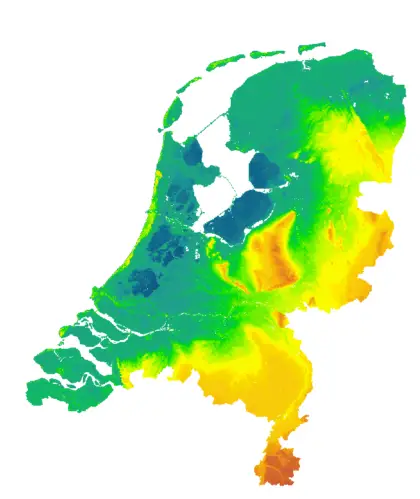
The map to the left provides an overview of the Netherlands’ altitudes compared to the “average sea level“.
The blue and dark green parts are below sea level and most vulnerable to flooding. It is important to realize that sea levels vary by 1-2 meters daily, depending on the tides and (severe) storms.
Therefore, even land above the average sea level is vulnerable to storm flooding. 59% of The Netherlands is vulnerable to flooding because it is less than 1 meter above the average sea level. Therefore, even though only 26% of the Netherlands is below the average sea level, the hard reality is that 59% of The Netherlands is vulnerable to flooding in case of severe storms.
Therefore, protection against flooding is paramount for the Netherlands to survive. This vulnerability is why the Zuiderzee Works and Delta Works were of existential importance.
Unfortunately, the catalyst to initiate the Delta and Zuiderzee Works was devastating flooding in both instances. The Delta Works were built after the flooding in the southwest in 1953 that killed almost 2000 people. The Zuiderzee Works started after the floodings in 1916 in the regions around the Zuiderzee.
Which Projects Are Part Of The Delta And ZuiderZee Works?
- The first project was building a dike, the Afsluitdijk, to close the Zuiderzee and turn it into a lake, the IJsselmeer.
- The second project was the reclamation of vast land areas, more than 2400 km2, from the IJsselmeer, creating an entirely new province, Flevoland.
- The Delta Works in Zeeland and Zuid-Holland are the flood defenses in the country’s southwest, consisting of 5 storm surge barriers, two locks, and six dams.
- The Hondsbosche Zeewering is a dike in the northwest part of the country which closes a hole between the natural dunes to have a continuous coastal defense line along the North Sea coast.
Where Are The Zuiderzee And Delta Works Located?
Why Was The Afsluitdijk Build?
For centuries, the Zuiderzee has been the inlet that stretched to Amsterdam. The Zuiderzee has been the gateway to Amsterdam from the North Sea. And Amsterdam’s tremendous development and wealth creation in the 16th and 17th centuries depended entirely on open access to the sea.
However, an open sea inlet also has disadvantages, like a higher risk of flooding. The floodings of 1916 killed dozens of people around the Zuiderzee and drove the decision to build a dike in the Zuiderzee to prevent future floodings in this area. Amsterdam’s access to the sea was already taken care of by a new canal, the North Sea Canal, that provided Amsterdam with direct and faster access to the North Sea.
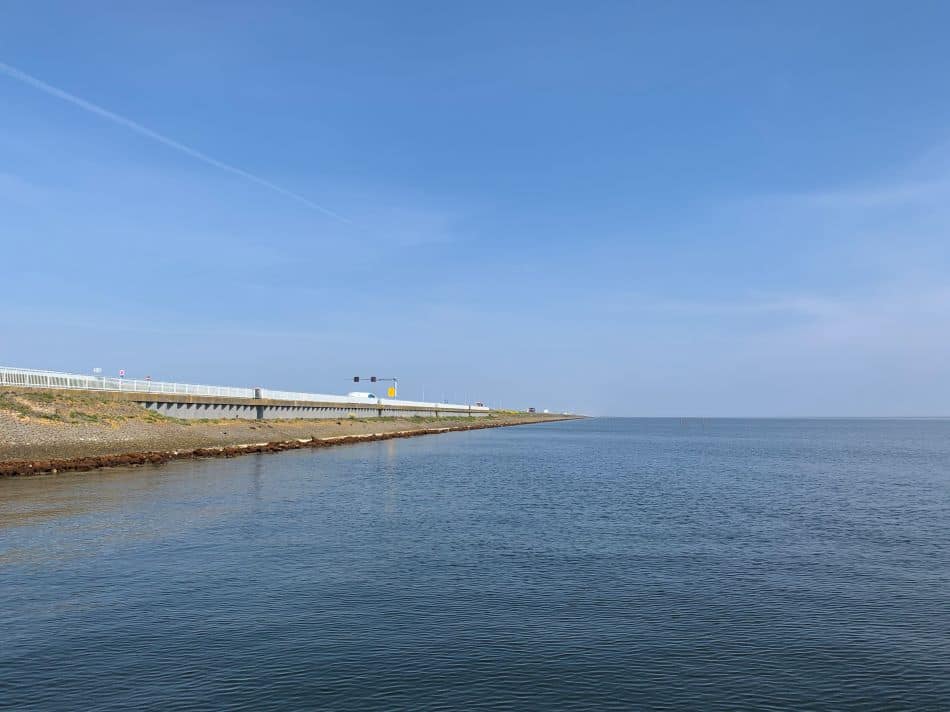
Work on the Afsluitdijk started in 1927 and finished in 1932. It turned the Zuiderzee into a lake called the IJsselmeer. The Afsluitdijk is 32 km long and was the longest dike ever built in its days.
Benefits Of Building The Afsluitdijk
The building of the Afsluitdijk was a significant accomplishment in those days and had two important benefits for The Netherlands.
- First and foremost, the land around the IJsselmeer was much better protected against flooding, which never happened again after building the Afsluitdijk.
- Second, creating the IJsselmeer allowed for an enormous land reclamation project. Land reclamation in a relatively calm lake is much easier than in an inlet of the sea.
What Were The Costs Of Building The Afsluitdijk?
The costs of building the Afsluitdijk were greatly underestimated during the development phase. The first calculations of fl 40 mln (€ 18,2 mln) proved wildly inaccurate. However, these miscalculations were probably good because the Afsluitdijk would never have been built otherwise.
The Afsluitdijk was finished in 1933, and when all costs were added up, the total cost to build the Afsluitdijk added up to fl 162 mln (€ 73,6 mln), almost four times more than the initial cost calculations.
That was a massive amount of money in those days. For comparison, total government spending in The Netherlands in 1933 was about fl 572 mln (€ 260 mln).
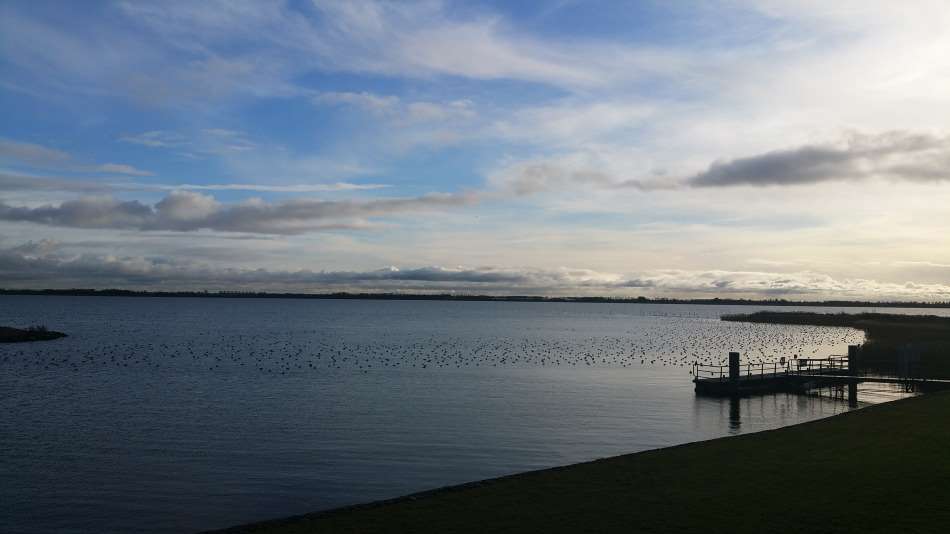
How Was Flevoland Created?
Land reclamation is something that the Dutch had done for centuries already. However, the land reclamation in the IJsselmeer took a much larger scale. More than 2400 km2 of land was reclaimed from the IJsselmeer, making it the world’s largest land reclamation project ever.
In comparison, land reclamation in the first large-scale land reclamation project in the 17th century, the Beemster Polder, led to 70 km2 of new land. The largest project in the 19th century, the reclamation of the Haarlemmermeer polder, created 170 km2 of new land.
Hence, land reclamation in IJsselmeer was much more extensive, and it took decades to conclude these projects. Nowadays, nearly 0,5 mln people live on this newly reclaimed land, and the new area is also extensively used for agriculture. Many farmers from the country’s west moved to this newly created land. Moving the farmers freed up precious ground in the western part of the country for houses, roads, and factories.
The video below provides an excellent explanation of how land reclamation occurs in practice. This video has been viewed more than one million times on Youtube.
The newly reclaimed land of Flevoland was much needed for agricultural purposes and immediately put to good use. The northern part of Flevoland has become a famous region for cultivating tulips, one of our national symbols.
What Are The Delta Works?
The Delta works were built after the floodings in 1953 in Zeeland and Zuid-Holland, which killed almost 2000 persons and flooded vast amounts of land. Those floodings made everybody realize how vulnerable this part of the Netherlands was. The floodings were an essential call to action to protect this area much better against the water.
The Delta Works in Zeeland and Zuid-Holland are the Netherlands’ defense systems against high water in the southwestern part of The Netherlands. The Delta Works has five storm surge barriers, two locks, and six dams.
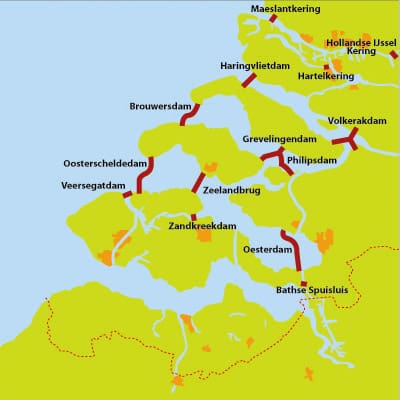
- The Delta Works is an innovative and elegant project which combines world-class civil engineering, hydraulic, and water management:
- Closing the sea’s open inlets shortened the coastline from 700 km to approximately 80 km, making it much easier to build and maintain.
- The storm surge barriers are unique because they are open when the weather is average, but they close when needed to provide optimal protection against the water.
The storm surge barrier in the Oosterschelde is the highlight of the Delta Works. This storm surge barrier is 9 kilometers long and has 65 pillars from 30 to 40 m high, anchoring firmly in the sea.
There are massive slides between these pillars that can go up and down. Visiting this storm surge barrier, the Oosterscheldedam is one of Amsterdam’s best possible day trips.
However, other parts of the Delta Works are equally essential to protect other parts of the country. For example, the storm surge barriers that can open and close to protect the rivers are particularly ingenious. The Hollandse IJsselkering and Maaslantkering are the best-known examples of storm surge barriers (see a picture of the Hollandse IJsselkering below).
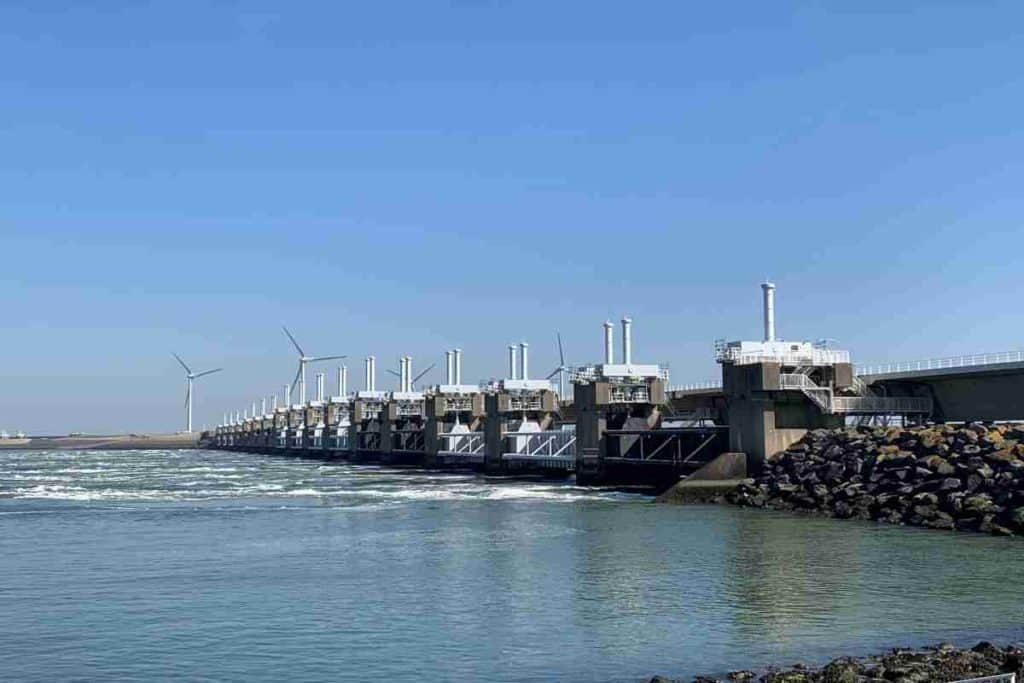
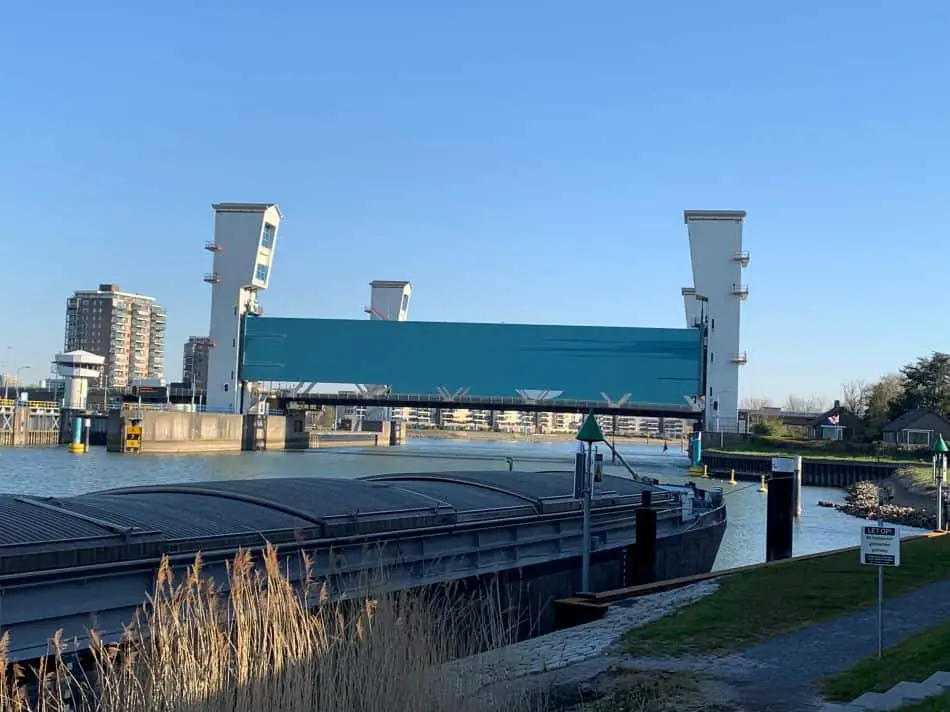
How Long Are The Delta Works?
The Netherlands is protected by 3700 km (2300 mi) of flood defenses. Approximately 250 kilometers (155 mi) of these flood defenses consist of natural dunes. Therefore, most flood defenses are artificial dams and dikes, about 1500, stretching for almost 3450 km (2144 mi).
Even though the Delta Works are the most famous flood defenses of the Netherlands, the total length of 51,6 km (32.1 mi) of the Delta Works is only a tiny part of all Dutch flood defenses.
The length of all the separate Delta Works dams, and dikes are shown in the table below.
| Project | length (km) | length (mi) |
|---|---|---|
| Oosterscheldekering | 9,0 | 5,6 |
| Grevelingedam | 6,0 | 3,7 |
| Brouwersdam | 6,5 | 4,0 |
| Veerse Gatdam | 2,8 | 1,7 |
| Zandkreekdam | 0,8 | 0,5 |
| Oesterdam | 10,5 | 6,5 |
| Volkerakdam | 4,5 | 2,8 |
| Philipsdam | 7,0 | 4,3 |
| Haringvlietdam | 4,5 | 2,8 |
| Total | 51.6 | 32,1 |
Why Was The Hondsbosche Zeewering Built?
The Hondsbossche Zeewering was a straightforward dike 5,5 kilometers long that filled a hole between the natural dunes along the northwestern coastline of The Netherlands. Massive storms and floodings created that hole in the dunes’ natural defense in the late Middle Ages.
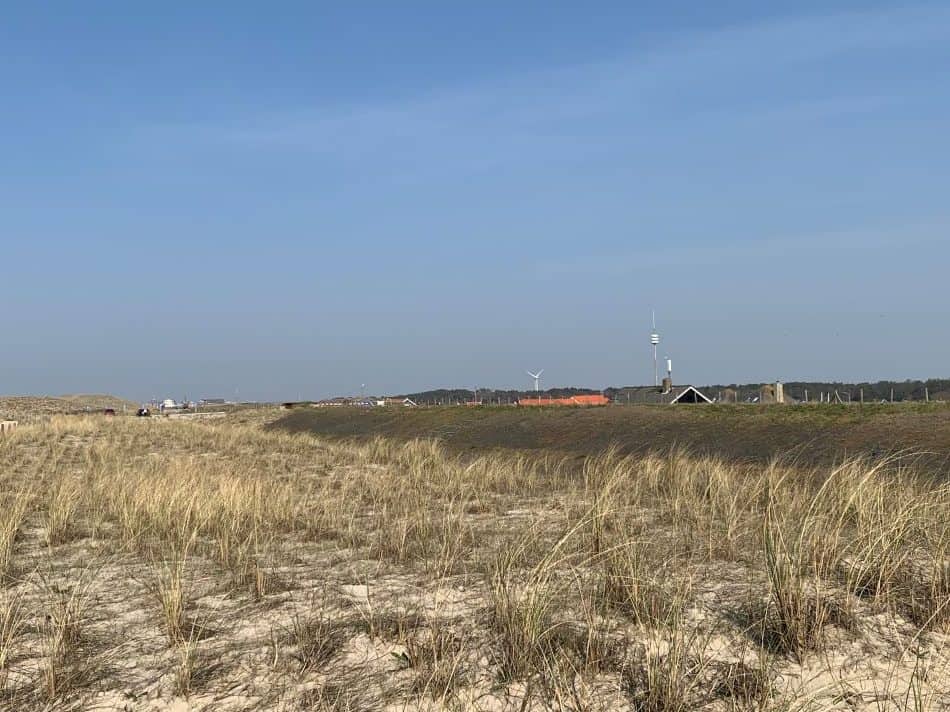
This dike has recently been turned into artificial dunes and beaches to further strengthen this part of the coastline. This project created a new attractive area for tourism at the same time. These pristine beaches are among the most beautiful beaches in The Netherlands.
Therefore, the Hondsbossche dunes and beaches are an elegant example of integrating flood defenses with other purposes to turn our weaknesses into strengths.
Can the Delta Works Cope with Rising Sea Levels?
The Delta Works and Zuiderzee Works were built to withstand the threat of the sea in the last century. However, one should realize that the Delta Works and Zuiderzee Works were not designed to withstand the magnitude of rising sea levels due to climate change.
Therefore, I have written another article on how rising sea levels due to climate change will affect The Netherlands.
The Netherlands will need a new Delta Plan if global warming does not slow down to prevent rising sea levels that threaten the Netherlands’ survival.

